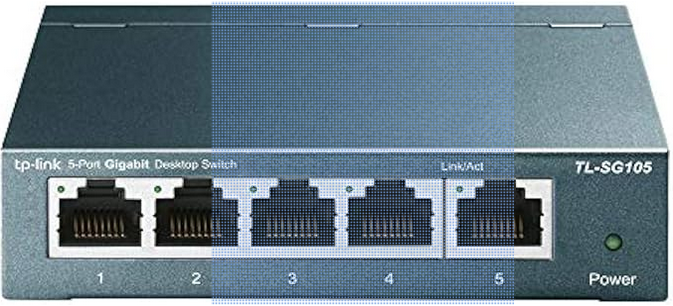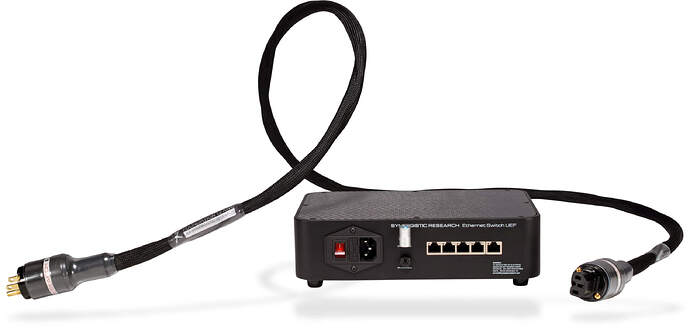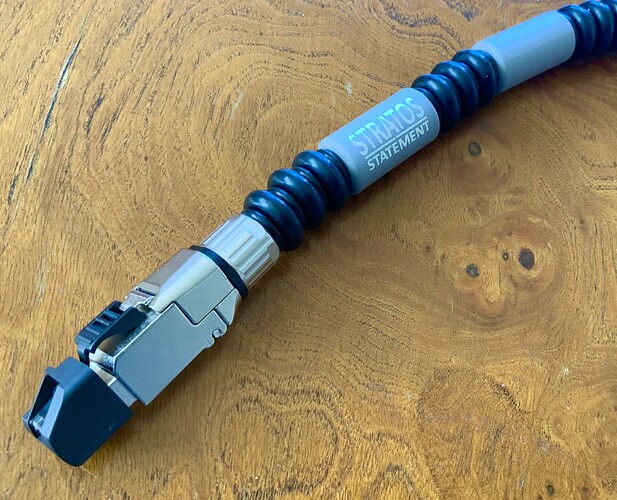I think the SR EUF switch is this repacked:

Well to ask the question a different way, how come I hear differences between switches and Ethernet cables even when playing locally stored ripped files from the SSD.
As far as I am concerned the answer is that the noise from the network gets into the streamer and hence into the dac no matter whether the music is being streamed via the network.
Ps, I definitely hear a difference if the network cable is unplugged.
I just tried that. Playing Qobuz track. Unplugged ethernet cable from my sonore optical module into my K30. Absolutely no change in the sound.
That’s another issue then. Most consumer Ethernet should be UTP (unshielded twisted pair) and that removes the ground plane.
So I think the issue is you shouldn’t be able to tell when the Ethernet cable is plugged/unplugged. CERTAINLY deserves investigation. I think you make have a setup/design issue.
I’ve a couple of JRIVER based systems were I have their pre-fetch/buffer maxed out and I can load an entire redbook encoded album in about .8 seconds and either disable the adapter or unplug it and get 50 minutes of playback and zero difference.
I also have some Raspberry Pi’s running RoPiee XL running with a POE injector and doing multicast to another setup of inputs on my DAC and A/B against the main system can’t tell what is what.
This brings my main system: I picked up a Juniper EX3300 48P PoE+ / 4 SFP+ (10GBe small form factor pluggable) for $49 shipped. I have wired with Single Mode OS1 and using 10GBe BiDi optics @ $40 a pop. Fed from a TrueNas server with a $20 Solar Flare SFP+ NIC.
This is going to a gen 7 i5 system with a SeaSonic PSU and aftermarket heatsink. You can’t even hear it.
The storage is Samsung Pro NVME M.2 and I’m getting ~1100MB/s.
All in $250 and I get 100% optical isolation and a 10X increase in speed that has a better design and engineering pedigree than any mom and pop outfit in the Audiophile industry could produce.
There also seems to be some confusion about STP and UTP cabling, when you use it, where you use it.
Good old UTP 5E is basically noise immune below 30MHz. STP cabling is were strong, externally produced, stray fields can’t be defeated by the CMNR nature of the twisted pair.
We are talking home settings where it’s not a source of concern. If Antipodes is shipping shielded cables they should be of the fully floated variety (fully floated is used in the horizontal run where concern is inter cable in a super large bundle (think 400-500 cables). There is only an outer foil shield not tied to ANY chassis.
I just put in a 12,000 port system over 58 IDF’s all using CAT6 UTP (only has that center spline) at a hospital system. This was one of 7 campuses. All your radiology, cardiology, labs, pyxis, imaging, etc run on this.
Agreed. Cat 5e UTP is all that is needed for any home system. Have you checked the supplied ethernet cables from Antipodes as to grounding? I used single mode fibre between my main network and the K30 mainly because it was easier to hide under existing trim.
We used 5E utp in many water and sewage treatment plants with large vfd’s with few problems. If we ran the cabling close to the drives we would sometimes use shielded cable grounded only at one common end. Not audio of course but extremely noisy compared to a home environment.
I’m not doubting some hear a difference with esoteric networking equipment. I would just like a measurement to show what noise has been mitigated.
What I’m trying to understand is the claims of decay, timbre, sound stage, clarity, etc. These are non-realtime systems using clock domain boundaries to keep things in order.
TCP, especially with fragmentation at the L3 gateway won’t even guarantee delivery of the packets in order. That’s literally all dumped on the receiver to re-order it all according to it’s sequencing.
The trouble with optical is that the conversion process is noisy. In my experience so far the worst possible sounding systems use optical. I am not alone in hearing this. As to speed, the speed requirements for home audio systems are not at all taxing for any network. Indeed due to living in an isolated location we have to use a 4G mobile/cell router and that has more than enough speed.
So I guess you demand to see measurements of the different Antipodes streamers before deciding which to buy or do you do the same as the rest of us and listen to the different models and chose which sounds best?
By the way, I am coming to the end of some prototype Ethernet cable listening and it is so far very interesting and far more influential than changing switches. ![]()
Hi Nick -be interested in your thoughts on this cable having tried the Muon Pro system which I sent back as it did nothing, also heard the Synergistic Research UEF switch but only for a short period not long enough to convince me .
Just out of interest what are you currently using in terms of switch isolation in your system.
Ps. Your recommendation for Squeeze has really opened my eyes as I’ve barely used Roon since.
What I’m saying is that a properly designed audio/video reproduction system shouldn’t exhibit network side operations.
I think Wifi is a ‘don’t let perfection get in the way of good enough’. I’m running vanilla $56 802.11AC 1350 AP’s at VTH40 and I’m getting 300mbps (38MB/s). Not even 24/192 can come close to saturating it.
I think issues that you may be exhibiting are some systemic design errors if by dint of having a cable plugged in has compromised your playback chain. I say this as a network engineer that gets to do AES67, Ravenna, AVB, heavy Multicast (PIM and IGMP) and it’s not uncommon for me to be ensuring 100GBe core and distribution for 4:2:2 1080 and 4K streams.
What is ‘Proto Type’. Technically if it can’t pass the current TIA 56A/B spec then I think you are better off with a Triplite patch as they guarantee if you throw it on a Fluke or Wavetek that they will pass.
I see standard industrial terminations.
I remember ArsTechnica did a blind A/B of Audoquest Ethernet and when they did their tear down I reached out to Lee and let him know the TeleGartner industrial terminations looked to be done by hand.
I put him in touch with Kurt and when Kurt put the supplied AQ on his fluke certifier it was on the bubble. Were I have a $12 Tripplite that has over double the margin of spec.
Hi Martin, I bought a Muon Pro and that incentivised me to develop something that was more in line with what I was looking to achieve in terms of sound. I think I am achieving that and I prefer that sound.
To answer you I am currently using a PhoenixNET switch to isolate my system from the the rest of the network in the house. Just as an aside I am seeing a number of expensive switches coming to market with cases milled from solid aluminium but where that is really where most of the cost has gone and the inner workings are just the same as a £20 Zyxel or other switch from Amazon.
Interesting as the power, jitter, and overall signalling requirements as you go up the speed chain increase significantly.
Good question. Taking it one step further, were measurements sought when deciding which app to run on Antipodes for best sound quality?
That we can hear differences between apps should tell us that our ears are incredibly sensitive to even the slightest changes in the noise profile affecting our systems. It stands to reason that a system that reveals clear differences between apps might also be very likely reveal clear differences when changes are made to the noise profile even further upstream.
It should be noted that I am not talking about the data changing. Bit perfect transmission was solved long ago. What hasn’t yet been solved is getting noise down to a level where it can’t cause harm that our ears can detect. Our very sensitive ears combined with our very sensitive components make that a tremendously difficult problem to solve if one’s goal is achieving the highest fidelity that one’s budget can allow. Remove any of these from the equation and it makes perfect sense to use consumer- or professional-grade networking products and computers.
It depends on what you mean by that. For sure it ought to work properly and without errors but unfortunately I have yet to come across an audio streaming device which is immune from network configuration and/or noise in terms of sound quality. A reviewer was heralding the Grimm MU1 as being the only streamer that he knew of which is immune from network configuration so I tried one and soon discovered that the reviewer was being somewhat optimistic in his pronouncement!
Most of your posts on this subject seem to be dominated by mention of achieved speeds but I suspect this has little effect on audio quality. Also I think you might be confusing me with other people who sell ‘audiophile’ ethernet cables which are completely homegrown and cannot possibly comply with any of the various standards. I know because I have purchased and taken apart many of those cables and have seen with my own eyes the lamentable ‘diy’ nature of their construction.
I come at this from quite a few years of selling my own BNC 75ohm RF filtering cables, all of which are based on using certified 75ohm cables and 75ohm connectors. So now when I am looking at ‘prototype’ ethernet cables I use certified cat 6 U/UTP cables using the TIA568B twin and pair assignments as the basis for the cables but with targeted extra noise filtering.
My referring to a prototype cable does not mean I am reinventing the wheel with regards to an uncertified diy attempt at an ethernet cables but rather I am comparing the effects of incorporating noise reduction with the cable. And yes I am fully aware of the noise mitigation incorporated in the cable configuration and the inherent galvanic isolation due to the ethernet standards but these standards have data integrity and protection against dc voltages and currents as their objectives and do not make claim to address sound quality by reducing noise piggy backing on the network cable.
You hint that all network cables constructed to the appropriate standard should have nil effect on audio playback but all I can say to you is that when I sit down and compare different network cables feeding my Antipodes Oladra I often hear differences (often, not always). This is with the Oladra connected to a Chord Dave + Mscaler DAC.
I have also said many times that it is my opinion that incorporating fibre conversion in the network immediately before the streamer adversely affects sound quality and this is easy to hear. This is why I am always skeptical of claims of fibre or optical in effect being noise free solutions to networking in audio systems. My experience is that this is far from reality.
I suppose what I am really saying through all this is that if all that mattered was error free data transmission through to the DAC then all the Antipodes streamers would sound the same (which they clearly don’t) and Roon would sound the same as Squeeze (which it clearly doesn’t).
By the way, on this subject, can you remind me which Antipodes streamer do you use?
Hello. I have something to add on the subject of audiophile switches. To summarize briefly and in bullet points, here are my additions, current status and other experiences. I also don’t use fiber optics. I’ve tried a lot of things and was rarely satisfied. To this day I’m comparing with offline operation (no network connected to the K50). Even though I know that offline operation is not the ideal opponent for a connected network. Because the server constantly asks about the network, it could cause additional noise. But it doesn’t sound like that to me. My configuration so far looks like this and is pretty close to my beloved offline operation. It’s really no joke and I’ve tried and compared it several times. The switch has long been the Tempus from Network Acoustics, from there it goes via the Muon Pro streaming package (filter + Ethernet cable) into the K50. Recently added the Eno2 filter, in front of the Tempus switch. My network has stayed the same. Fritz repeater with standard Ethernet cable in the Eno2 pre-filter. Sound quality is almost identical to offline operation. I’m very happy so far. I leave the network to be cleaned completely to Network Acoustics (Ethernet cable, switch and their filters). I’ve now requested the Muon Pro filter instead of the Eno2. What I like so far is that the sound is natural and not distorted. It’s very similar to offline operation.
I was introduced to Antipodes by a fellow Head-fi member but bought mine based on form and function. I bought your storm cables only after Rob Watts said they helped rfi mitigation. If you bring the ethernet cable in the picture to market will you be publishing rfi mitigation specs and ethernet compliance certification? Very nice looking btw.
I am almost certain I will bring my ethernet cable to the market. I do measure rfi mitigation (and have always done so for my other cables) but I would never publish this because I have found from experience that those who request measurements normally only want them to dispute them and have an argument whereas potential customers just just listen and say, “Wow that sounds amazing”.”


